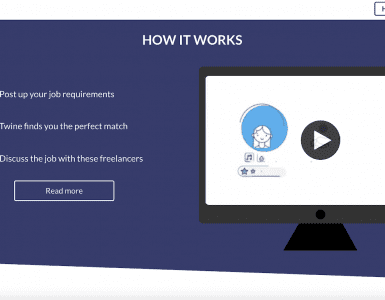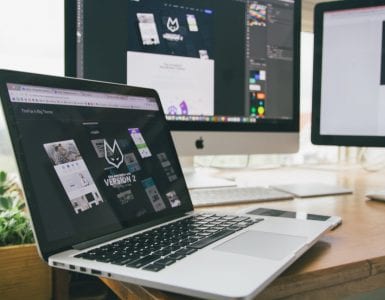A company logo is reputedly the most important part of your business. A bad one could sink you, an excellent one will set you up for life. But what actually goes into creating one?
Some of the best logos out there are so simple, it can seem like child’s play to the uninitiated. Plus, designers these days have super-advanced software programmes like Illustrator and Photoshop which basically do the whole thing for you in five minutes, right?
Well, it might not be as simple as it first appears. We’re here to bust a few myths when it comes to crafting a company identity.
We’ll take you from concept to completion to show you what it really takes to make a logo. We’ve created a fictional company called Wine House. They’re in a need of a new logo and we’ve set them up with a fictional designer to complete their project. Our pretend company logo, Wine House, is nowhere near as polished or refined as a professional logo created by an experienced designer would be, but you’ll get the general idea. So how does it start?
-
Research


Designer and client will sit down together and discuss the project requirements. The client will outline their personal style, taste and tell the designer a little bit about what their company does. Our fake company, Wine House is a high street wine shop. Wine House are a family run business spanning 2 generations. They want to reflect this with classic, formal colours and a logo that depicts what they sell. The designer will begin to get a good feel for the company and build a picture of what the client wants.
After the meeting, the designer will go away and do some research. Firstly, competitors in the industry will be researched. What other wine shops are out there? Who’s operating in the local area? All this is important stuff because you want your logo to stand out from your competitors. Also, you’ll need to know what your competitor’s logos look like so that you don’t accidentally create something exactly the same.
Next, it’s time to find some inspiration and get the designer’s creative juices flowing. They’ll probably do some research into icons, pictograms, illustrations and logomarks – for example, for our logo our designer researches wine and houses.
Sites like Pinterest, Dribbble and Behance are excellent playgrounds for design research. The designer can quickly get access to hundreds of design examples to whet their appetite.
Every designer does research differently. Some use books. Some designers create moodboards for their clients – these are collections of colours, logos, fonts and images that match a certain look or style. That way, the designer can be sure the client is going to like what they create, before any design work has been undertaken.
-
Sketches


And you thought it was all done on computer these days? Not so my friend. One of the quickest ways to get a concept down is to put pencil to paper. In fact, the designer may even have started sketching out initial ideas during the research phase.
Sketching is important as the designer can get lots of ideas recorded down quickly. If there’s one that’s not working, they can just move on – no time wasted.
Some designers send their initial sketch ideas along to their client when they present their finished logos to them. Sketches show that although only one finished logo is produced, there were actually many ideas and concepts that went into producing that one finished design. This is a part of the process that’s often lost on clients, since they only usually see the end product.
‘Why make so many logo ideas if you only end up using one?’ you may ask. Multiple ideas need to be created in order to see which one actually works the best. You can compare them all against each other and the best designs will instantly stand out. If you settle for the first idea you happen upon, you’ll never know whether there’s a more effective design out there for you.
-
Initial concepts


From those initial sketches, a few strong ideas will be taken forward and fleshed out in a computer software package, usually Illustrator as this produces vector artwork which is most suitable for logos. The designer will develop and expand their original ideas to look more like a real logo. They are still concepts though, so they could look a little rough and ready round the edges.
These initial concepts will be the first artwork that is shown to the client. The designer may show a range of concepts and ideas here. The designer and client can have a feedback session to discuss the concepts. The designer can talk through the ideas behind each design and the client can give their feedback and comments.
The client will decide which of the logo concepts they like best, and these will be taken forward and developed into a more polished logo. By this stage, it might be clear which will be the winning logo, or the client may still need to see a few designs refined before they can decide.
-
Refining the chosen concepts




The next step is to refine the chosen concepts into fully formed logos. Depending on how the feedback session went, the client may have suggested multiple changes, so these will need to be incorporated into the design.
This is the stage of the process that really takes time. It’s time to make those rough concepts look polished and professional. It’s time to play around with multiple colour ways and fonts, seeking out what works best for the company and brand. It’s time to test whether the logo will work on a dark background and at different sizes.
If the client is very sure of what they want, this stage can be completed quickly. If the client is still unsure what they want their finished logo to look like, this stage might require more revisions and versions of the logo to be made.
Then, the designer will once again sit down with their client and review the refined logo designs. From here the client will need to choose the concept that they want to take forward into a finished logo.
-
The completed logo


The final stage of the process is to make any last changes requested by the client and add the finishing touches to the chosen logo concept. The client is now happy with the logo design and this stage is all about finishing up loose ends and dotting the i’s and crossing the t’s. The designer needs to check and double-check for mistakes or typos. The logo now needs to be just perfect, because after this the logo will be out in the wild and being used for real. Any mistakes will reflect badly on the designer.
Every designer is different, but many make a special presentation document to hand over the final logo to the clients. This includes their logo set out in various formats, colour palettes, typography, and any other branding design decisions that were made during the process.
Once the logo is perfected, the designer can go about preparing it for the client. The client will usually need the logo in a variety of file types and formats. For any given logo there are often many versions of it that need to be created:
– Version for print (CMYK)
– Version for digital (RGB)
– Version for small sizes (often simplified, and detailed elements removed)
– Version for large sizes
– A version that works on dark backgrounds
– A version that works on light backgrounds
– Different combinations, such as with text, without text, text-only etc
And there could be more. So you can see, there’s quite a bit of work for the designer to do here. Not only that, each version of the logo then needs to be saved into several different file formats for the client depending on their needs – .ai, .eps, .png, .jpg etc. The client will need to be able to use their logo in ANY situation, so the designer needs to be able to future-proof for this.
Then, all that’s left is to hand the finished logo over to the client.
A new logo design is a great starting point for improving other areas of the client’s company. The logo can be used as a basis for implementing further branding changes like stationery, business cards, signs, websites and more.



